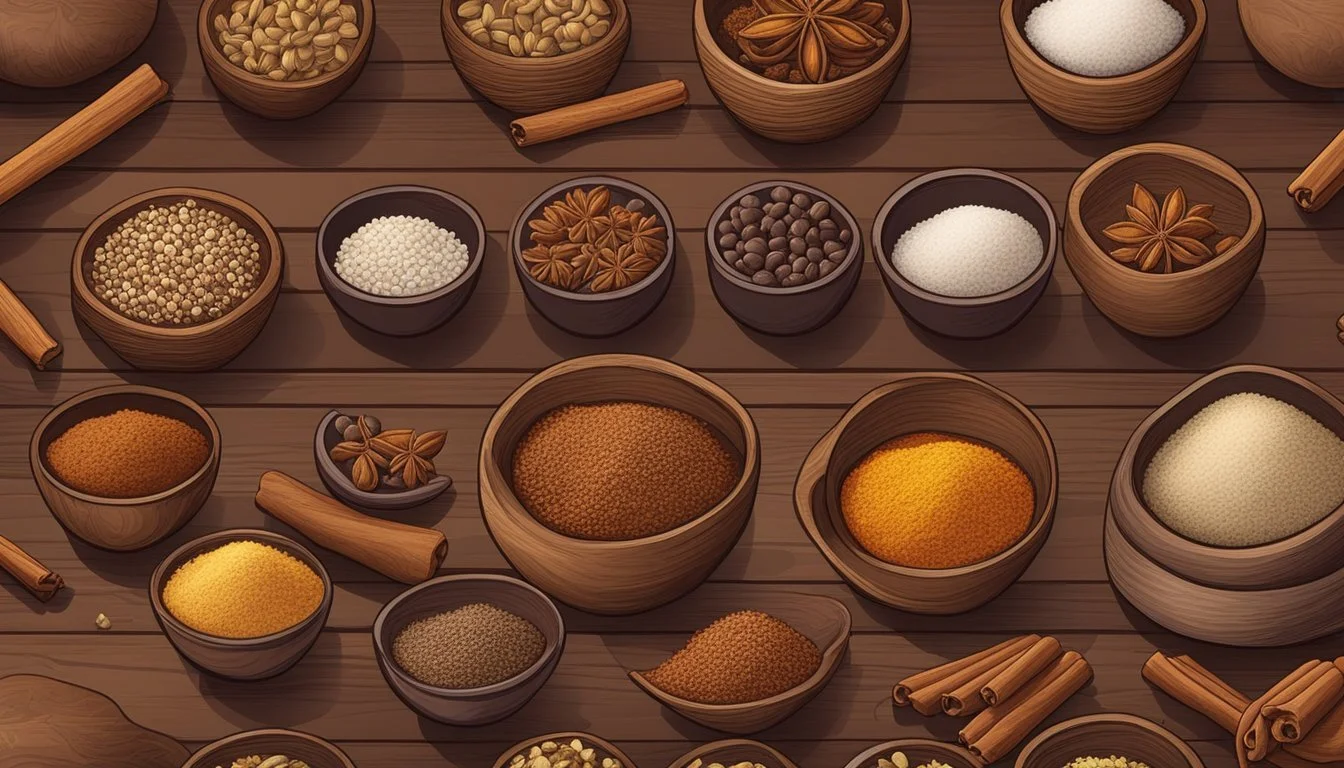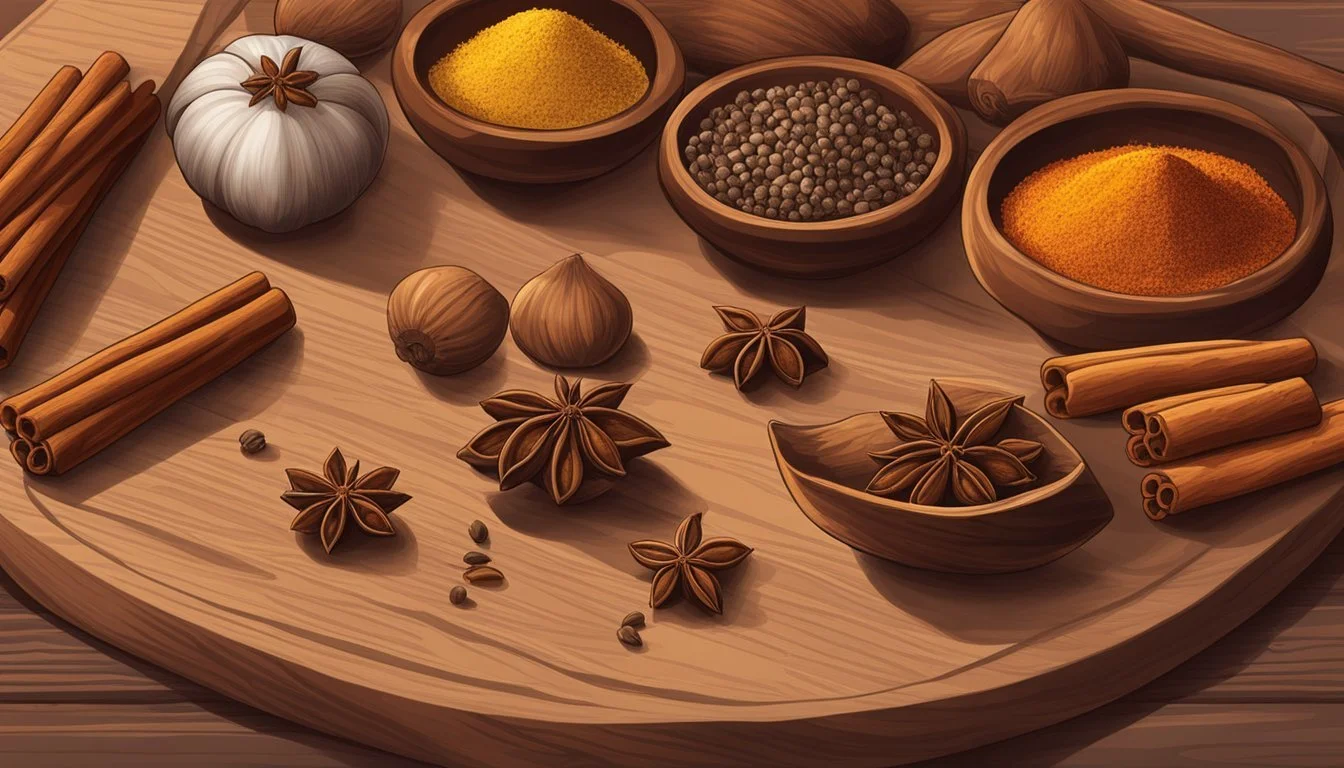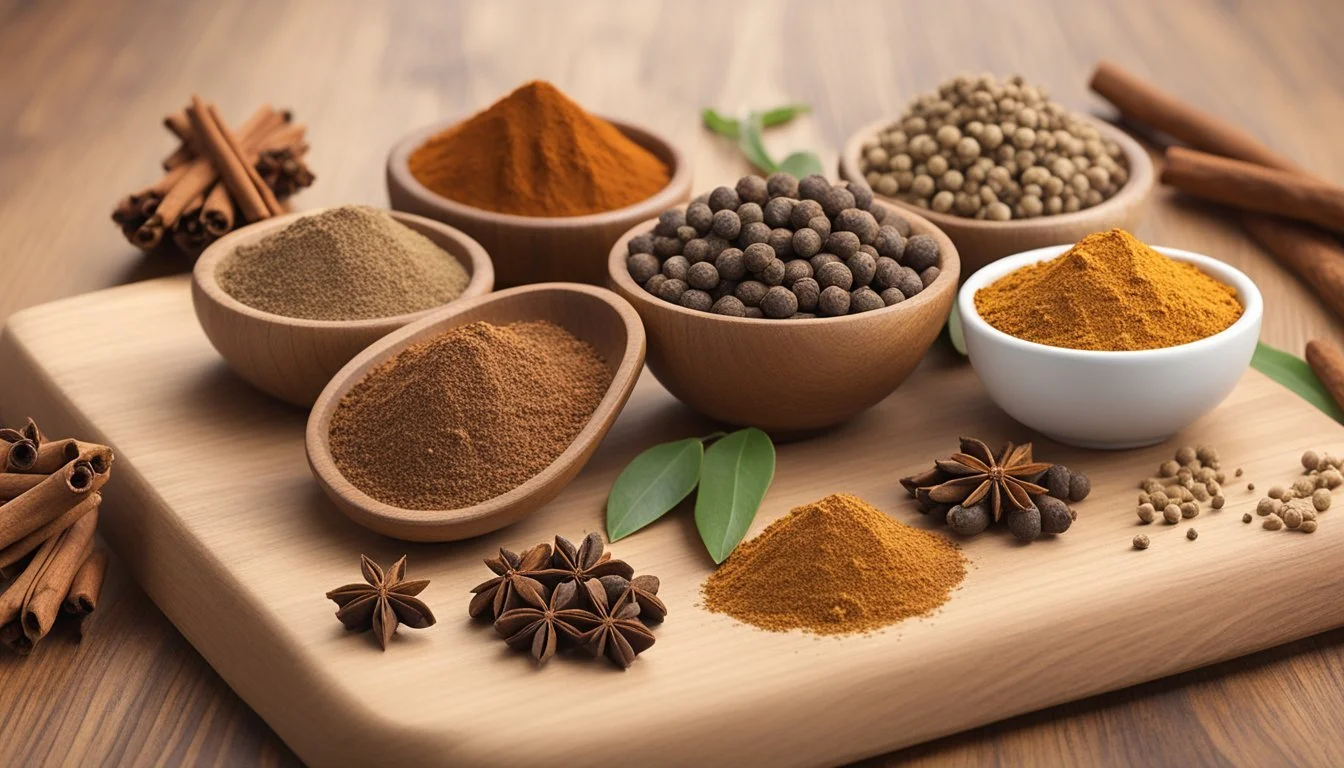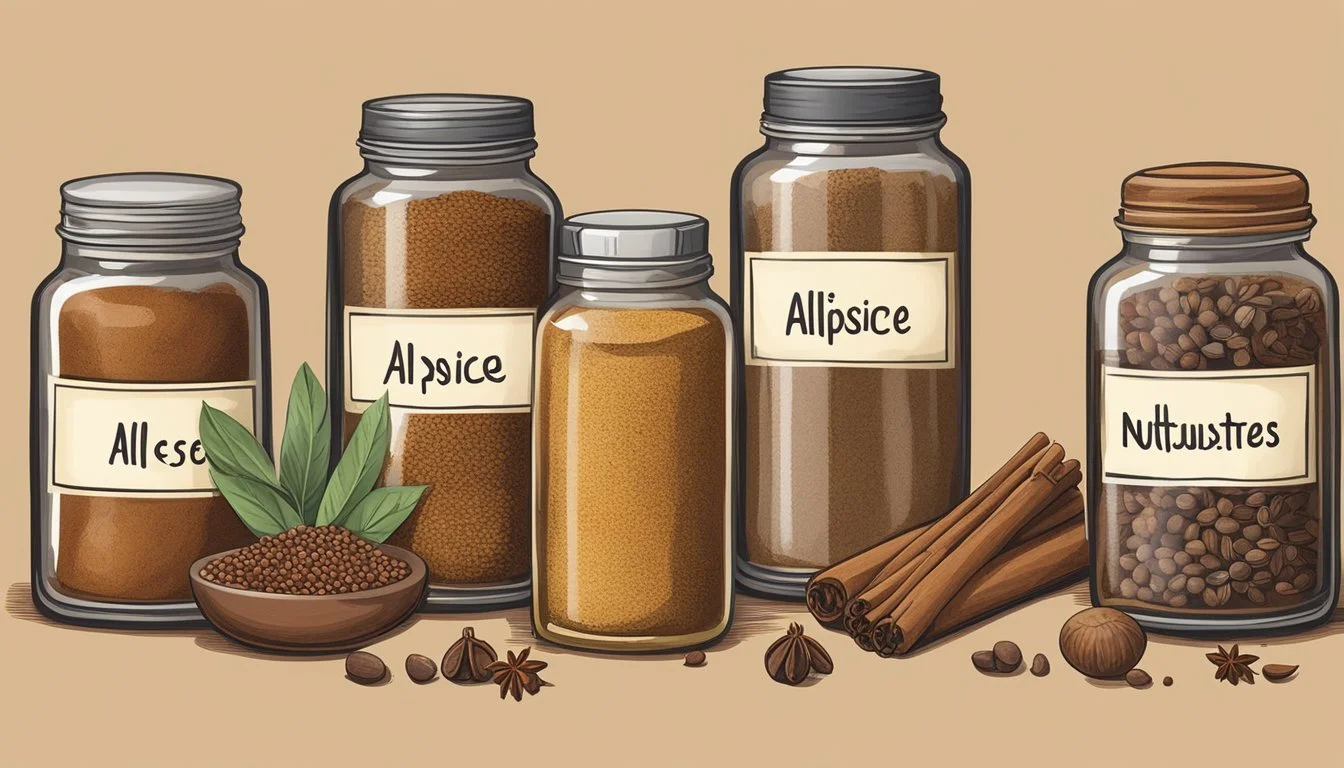Allspice Substitutes
Top Alternatives for Your Spice Rack
Allspice, a quintessential component of numerous spice blends, carries a complex flavor profile that encapsulates the warmth of cinnamon, the sharpness of cloves, and the comforting essence of nutmeg. Characterized by its rich aroma and a sweet, peppery taste, allspice often plays a pivotal role in both sweet and savory dishes; it's especially prominent in Caribbean and Middle Eastern cuisines. However, its distinctive taste can sometimes overshadow other flavors if not used judiciously, particularly when substituting for it.
The need for a substitute might arise when this spice is missing from the pantry or when a less potent ingredient is desired to balance a dish. Individuals looking for allspice substitutes should seek out alternatives that can mimic its unique warmth and depth. Ground cloves, with their potent flavor, can be a good starting point when used sparingly in a 1:2 ratio with the intended amount of allspice. On the other hand, nutmeg offers a milder warmth, ideal for dishes where a gentle spice background is preferred.
For those seeking a blended substitute, equal parts of cinnamon and nutmeg, or a crafted mixture of 1/2 teaspoon of cinnamon with 1/4 teaspoon each of nutmeg and cloves, can approximate the flavor profile of allspice. Such combinations allow for flexibility, ensuring that the final dish retains the desired flavor intensity. It is important to account for the potential variability in taste between the actual spice and its substitutes, adjusting quantities accordingly to achieve the intended result.
Understanding Allspice
Allspice, derived from the Pimenta dioica plant, is integral to numerous cuisines, providing a distinctive warm flavor. This section explores its origins, characteristics, and culinary applications.
Origins and Characteristics
Allspice hails from Jamaica, where the Pimenta dioica tree, native to the region, bears the berry. The name "allspice" is attributed to the berry's complex flavor that resembles a blend of cinnamon, nutmeg, and cloves. Whole allspice berries are small, brown, and typically dried, preserving their aromatic qualities.
Botanical Name: Pimenta dioica
Region: Jamaica and other parts of the Caribbean
Description: Aromatic, warming spice with a flavor suggesting a blend of spices
Culinary Uses
Allspice plays a versatile role in both sweet and savory dishes. In Jamaican cuisine, it's a signature component in jerk seasoning, imparting a warming, earthy note. As a whole allspice berry, it's often used to infuse flavors into stews (What wine goes well with stews?), marinades, and even beverages like mulled wine.
Savory Dishes: Incorporates a robust depth to meats, soups, and stews
Sweet Dishes: Enhances pies, puddings, and various baked goods
By understanding allspice's rich background and distinct taste profile, cooks and chefs can better utilize this spice to elevate their dishes.
Best Allspice Substitutes
When a recipe calls for allspice and there's none to be found in the pantry, there are several other spices that can be used as stand-ins. These substitutes can closely mimic the complex warmth of allspice and can be used with ease in both sweet and savory dishes.
Ground Cloves
Ground cloves provide a strong, pungent flavor that resembles the intensity of allspice. Typically, one should use about half the amount of ground cloves when substituting for ground allspice to avoid overpowering the dish.
Ground Nutmeg
Ground nutmeg offers a sweet, warming flavor similar to allspice. It is especially effective as a substitution in sweet recipes. Use it in a one-to-one ratio when replacing ground allspice.
Ground Cinnamon
Ground cinnamon shares the sweet and woody notes of allspice. It can be used in equal amounts as a substitute, keeping in mind that it lacks the peppery punch of allspice.
Pumpkin Pie Spice
Pumpkin pie spice is a blend that usually includes cinnamon, nutmeg, ginger, and cloves. Since it captures the essence of allspice's flavor profile, one can use an equal measure of pumpkin pie spice as a substitute for ground allspice.
Mixed Spice
Similar to pumpkin pie spice, mixed spice contains a blend of cinnamon, nutmeg, and allspice, among other ingredients. This makes it a suitable alternative, used in the same quantity as allspice.
Apple Pie Spice
Apple pie spice blend, which typically consists of cinnamon, nutmeg, and allspice, can be another fitting replacement. It can be used in the same proportions when substituting for ground allspice.
Garam Masala
Garam masala, a staple in Indian cuisine, has a complexity that can imitate allspice's flavor. It should be used sparingly, as it combines a variety of spices that go beyond allspice's singular taste profile.
Using Spices to Mimic Allspice Flavor
Certain spices can be combined to recreate the rich and warm profile that is characteristic of allspice. This can be particularly useful when allspice is unavailable or someone aims to achieve a similar taste through separate spice components.
Creating a Spice Blend
A carefully measured spice blend can closely approximate the complex flavor of allspice. The recommended combination is equal parts of ground cinnamon, ground cloves, and ground nutmeg. Here is a simple table that outlines the ratios needed to create an allspice blend:
Quantity of Allspice Needed Ground Cinnamon Ground Cloves Ground Nutmeg 1 teaspoon ⅓ teaspoon ⅓ teaspoon ⅓ teaspoon
By mixing these together, cooks can achieve a balance of sweet, earthy, and pungent notes that mimic allspice's essence in both sweet and savory recipes.
Individual Spice Combinations
Alternatively, chefs may use a single spice to stand in for allspice when the particular complexity of allspice is less important for the overall flavor of the dish. For instance, ground cloves can be a direct substitute, delivering a strong, warm spice note. Ground nutmeg offers a softer, earthy warmth and works well as a substitute, especially in savory dishes, such as sausages, and can also complement sweet recipes effectively.
It is important to note that when using individual spices as substitutes, the proportions may need adjusting according to one's taste preference and the recipe's requirements.
Substitutes for Specific Dishes
When cooking, the appropriate allspice substitute can vary based on the type of dish being prepared. This section breaks down the best allspice alternatives for savory dishes, baked goods, and sauces, ensuring the flavors are tailored to the context of the recipe.
Savory Dishes and Meat Seasoning
For savory recipes involving meats and other robust dishes, fresh ground nutmeg brings a mild warmth that complements the flavors without overpowering them. It’s particularly well-suited for meat seasonings, adding an earthy spice that mirrors the complexity of allspice.
Meat Seasoning Blend:
1 teaspoon ground cinnamon
1 teaspoon ground nutmeg
1/4 teaspoon ground cloves
Use this blend in a 1:1 replacement for allspice in your savory dishes.
Baked Goods and Sweet Recipes
In baking and sweet recipes, such as desserts and bread, a combination of cinnamon, nutmeg, and cloves can replicate the aromatic warmth allspice typically provides.
Baking Spice Blend:
2 teaspoons ground cinnamon
1 teaspoon ground nutmeg
1/2 teaspoon ground cloves
Mix together and use equal amounts as allspice in your baked goods.
Stews and Sauces
For stews and sauces, where a subtle, multifaceted flavor is essential, ground cloves provide a pungency with sweet notes, making it an ideal substitute. Their deep color also won’t alter the visual appeal of darker dishes.
Stew and Sauce Blend:
1 part ground cloves
A pinch of black pepper
Use this combination as a 1:1 replacement in sauces and stews to add depth and sweet warmth.
Alternative Ingredients with Similar Attributes
Selecting the right substitute for allspice depends on the specific characteristics of the desired flavor profile. This section explores alternatives that possess similar attributes to allspice, focusing on their distinct flavors and applications.
Star Anise
Star anise is noted for its licorice-like, sweet flavor, which can be a good match for allspice's warm tones. It's particularly effective in Chinese cuisine and often used in braising and baking. To replicate the complexity of allspice, one can use star anise sparingly.
Black Pepper and Peppercorns
Black pepper offers a spicy kick that mirrors the peppery bite of allspice. Freshly ground black pepper or whole peppercorns can be utilized to add heat to savory dishes where allspice would typically be a component. It's advisable to use black pepper in smaller amounts to avoid overpowering other flavors.
Fennel and Mace
Both fennel and mace share a sweet warmth akin to allspice. Fennel seeds add a mild anise flavor perfect for savory applications, while mace, the outer layer of nutmeg, delivers a less intense but similar taste to allspice. Mace works well in sweet and savory dishes alike, adding a subtle complexity.
Homemade Allspice Substitute Recipes
When allspice is unavailable, one can recreate its warm, fragrant profile using a blend of common spices or by grinding whole spices at home. These methods are practical and straightforward, allowing the user to maintain the intended flavor of the dish.
DIY Spice Blend Instructions
To make a homemade allspice substitute, one can mix the following ground spices in these proportions:
Cinnamon: 3½ teaspoons
Nutmeg: 1¼ teaspoons
Cloves: A pinch
Instructions:
In a small bowl, combine the cinnamon, nutmeg, and cloves.
Use the blend in a 1:1 ratio for recipes requiring ground allspice.
This DIY spice blend is versatile for both sweet and savory dishes, ensuring a balanced and complex flavor similar to that of allspice.
Grinding Whole Spices at Home
For those who prefer using whole spices to achieve a fresher flavor, a spice grinder or coffee grinder can be utilized to grind the spices just before cooking. To replace whole allspice berries:
Whole Spices Needed:
Cinnamon sticks
Whole nutmeg
Whole cloves
Grinding Instructions:
Measure out the whole spices in proportionate amounts similar to the ground spice blend.
Place the spices into a spice or coffee grinder.
Pulse until a finely ground powder is achieved.
Grinding whole spices maximizes the flavor and aroma, and is a superior option when freshness is paramount for the recipe at hand.
Additional Uses of Allspice and Its Substitutes
Allspice and its substitutes play a versatile role in culinary applications, enhancing beverages, spice mixtures, and pickling processes with their distinct flavors.
In Beverages and Seasonal Drinks
The warm and aromatic qualities of allspice make it ideal for fall and winter beverages. A common spice in mulled wine and mulled cider, allspice adds a comforting warmth to these drinks. When allspice is unavailable, a combination of cinnamon, nutmeg, and cloves can be used. For example, chai recipes often incorporate these substitutes to mimic the complex flavor profile of allspice.
Beverage Substitutes:
Mulled Wine: Use a pinch of five-spice powder as a complex alternative.
Chai: Incorporate a blend of equal parts ground cinnamon and ground nutmeg, with half the amount of ground cloves.
Seasonings, Rubs, and Marinades
Allspice is an invaluable component in seasoning blends such as Jamaican jerk seasoning, imparting an authentic Caribbean flavor to dishes like jerk chicken and fish. In the absence of allspice, many chefs create a similar sensation using equal parts cinnamon and nutmeg or a mix of half a teaspoon of cinnamon and a quarter teaspoon each of nutmeg and cloves. For Middle Eastern spice rubs, substitutes like pumpkin spice mix or an improvisation of the classic allspice and other warming spices can be used.
Marinades and Rubs:
Jerk Seasoning: Combine ground cinnamon, nutmeg, and cloves in equal parts.
Sausage Seasoning: Substitute with freshly ground nutmeg for earthy notes.
Pickling and Preservative Uses
The preservative properties of allspice make it a staple in pickling liquids, where it contributes a subtle depth of flavor. In pickling, alternatives like clove or cinnamon can be used, typically enclosed in a cheesecloth for easy removal. When allspice berries are needed for pickling, a practical DIY blend is to mix ground spices in small, controlled amounts.
Pickling Spice Mix:
Whole Spices: Substitute ¼ to ½ teaspoon of a blend of ground cinnamon, nutmeg, and a pinch of cloves for 6 whole allspice berries.
Chili Pickling: Opt for a spice rub mixture with added warmth from ground spices.
Nutritional Profile and Health Benefits
Allspice boasts a low-calorie profile while providing a depth of flavor to a variety of dishes. Despite its minor contribution to daily nutrient intake, it contains compounds associated with health benefits.
Caloric and Nutritional Content
Allspice contains a negligible amount of calories and nutrients. Its usage primarily serves culinary purposes for its taste rather than nutritional value. However, a breakdown for a small quantity, such as 1 teaspoon (approximately 1.9 grams) of ground allspice, demonstrates its minimal contribution to daily dietary requirements:
Calories: Nearly zero
Carbohydrates: Minimal
Sodium: Insignificant
Potential Health Impacts
While allspice is not a significant source of nutrients, the compounds within have been linked to positive health effects. The spice contains polyphenols and antioxidants, substances that may contribute to its potential cancer-fighting properties. These bioactive compounds can interact with the body at the cellular level.
Research suggests that extracts from allspice can suppress the growth of certain cancer cells, including prostate cancer. Because these findings are based on specific compounds in concentrated forms, the actual health impact of consuming allspice in culinary quantities may differ. It remains a subject of scientific interest and further study.
Cultural Significance of Allspice
Allspice, derived from the Pimenta dioica plant, is more than just a spice; it represents a confluence of cultural identities and culinary practices from the Caribbean to various corners of the globe.
Allspice in Caribbean Cuisine
In the Caribbean, allspice is a cornerstone of the region’s cuisine, often associated with Jamaican dishes. The spice is celebrated for its ability to impart a rich, warm, and complex flavor profile that has become synonymous with iconic Caribbean recipes. Jamaican jerk seasoning relies heavily on allspice, which complements the fiery notes of Scotch Bonnet peppers. Its use is not limited to meat dishes; allspice also finds its way into an array of sauces, stews, and even certain desserts, showcasing its versatility.
Typical Uses:
Jerk seasoning for meats
Marinades and sauces
Traditional stews
Puddings and sweet treats
Global Influence and Uses
Allspice’s influence extends far beyond the Caribbean and Central America, having been incorporated into Middle Eastern recipes and other international cuisines. The spice's journey across the globe is a testament to its adaptability and the way it can complement diverse ingredient profiles. For instance, in the Middle East, allspice is a subtle yet integral component in a variety of meat dishes and is often used in spice blends.
Global Uses:
Spice blends for meats and stews
Seasoning in rice dishes
Aromatic in baked goods
Its widespread adoption has made it a global pantry staple, signifying not just flavor, but a mosaic of cultural heritage carried through its use.
Conclusion
For cooks seeking allspice substitutes, several options provide a close match to its warm, aromatic flavor. Cinnamon, nutmeg, and cloves stand out as individual spices that can mimic allspice’s nuanced taste profile. Here’s a succinct guide to substituting allspice:
1 tsp allspice = 1/2 tsp ground cinnamon + 1/4 tsp ground nutmeg + 1/4 tsp ground cloves
These spices can be blended to create a homemade allspice alternative that suits both sweet and savory dishes. Cloves, with their sweet yet pungent flavor, make an excellent solo substitute, especially when appearance and color consistency in dishes is paramount.
In savory recipes, like sausages, nutmeg offers a similar earthiness and mild warmth, while cinnamon delivers a gentle sweetness, useful across various recipes. Below is a quick reference table for replacing allspice:
Quantity of Allspice Substitute with Cinnamon Substitute with Nutmeg Substitute with Cloves 1 tsp 1/2 tsp 1/2 tsp 1/2 tsp
Other flavorful blends like pumpkin pie spice or five-spice powder can be used in pinches for a more complex bouquet of flavors. Herbs are generally not direct substitutes for the sweet warmth of allspice.
When one is out of allspice or it's inaccessible, these substitutes ensure that dishes retain their desired taste without compromising on flavor. It is advisable to start with a conservative amount of any substitute to maintain balance in the dish's flavor profile.







